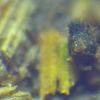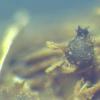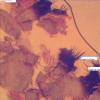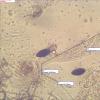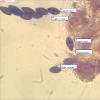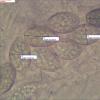
18-12-2025 21:17
Pol DebaenstThe identification took me to Byssonectria deformi

15-12-2025 07:09
 Danny Newman
Danny Newman
indet. Rutstroemiaceae sp. on unk. fallen leavesMc

19-12-2025 10:10
Patrice TANCHAUDBonjour, récolte réalisée en milieu dunaire, a

18-12-2025 17:23
 Bruno Coué
Bruno Coué
Bonjour,je serais heureux d'avoir votre avis sur c

18-12-2025 18:07
Margot en Geert VullingsThese plumes were found on rotten wood.They strong

17-12-2025 18:35
 Michel Hairaud
Michel Hairaud
Bonjour à tous/Hi to everyone I am passing along

15-12-2025 15:48
 Danny Newman
Danny Newman
Melanospora cf. lagenaria on old, rotting, fallen

15-12-2025 15:54
 Johan Boonefaes
Johan Boonefaes
Unknown anamorph found on the ground in coastal sa

15-12-2025 21:11
 Hardware Tony
Hardware Tony
Small clavate hairs, negative croziers and IKI bb
Schizothecium pilosum
Joop van der Lee,
12-08-2013 15:40
 Found on horse dung.
Found on horse dung.Riged and agglutinated haris arise from the neck base, they are septated with a rounded top 79.12-91.01x2.21-2.47 um.
Asci: 218.91x14.24-28.61 um, 8-spored with a long, lobate stalk.
Spores: Biseriate, when young filled with a lot of bubbles, 19.78-24.49x11.30-11.54 um, pedicel 14.24x4.63 um, caudas at each pole are present. Caudas were only visible on young spores while in the ascus they collapse quickly when spores are mature.
Norbert Heine,
15-08-2013 00:43

Re : Podospora Pilosa?
Hello Joop!
Your fungus is not Schizothecium pilosum (Mouton) N. Lundq.!
This is the current name for Podospora pilosa. Please look at MycoBank or IF.
Schizothecium pilosum has beside the stiff hairs typical, but often reduced, hairs of the Schizothecium type at the neck, the asci are enlarged and flattened at the apex and it has other spores.
What you show should be Podospora ellisiana (Griffiths) Mirza & Cain.
It seems to be a rare species, which I found only two times, once on horse dung in Germany and once on cow dung in Italy!
Great find!
Best wishes
Norbert
Your fungus is not Schizothecium pilosum (Mouton) N. Lundq.!
This is the current name for Podospora pilosa. Please look at MycoBank or IF.
Schizothecium pilosum has beside the stiff hairs typical, but often reduced, hairs of the Schizothecium type at the neck, the asci are enlarged and flattened at the apex and it has other spores.
What you show should be Podospora ellisiana (Griffiths) Mirza & Cain.
It seems to be a rare species, which I found only two times, once on horse dung in Germany and once on cow dung in Italy!
Great find!
Best wishes
Norbert
Joop van der Lee,
15-08-2013 09:20

Re : Podospora Pilosa?
Vielen dank Norbert.

